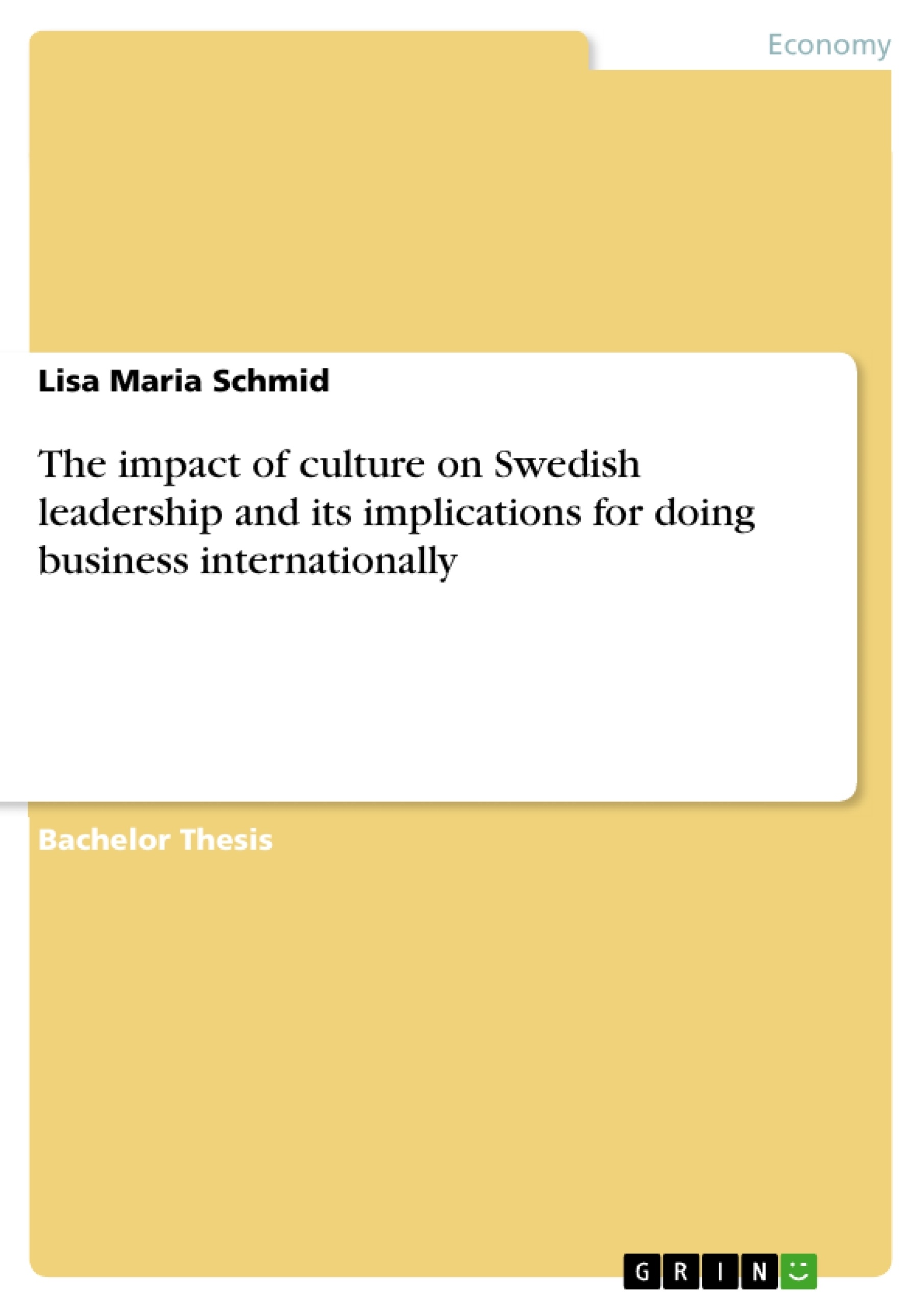This thesis aims at understanding how culture influences the leadership style of Swedish managers and the implications that this has for other countries in doing business with them. Additionally, this thesis seeks to understand which impact globalization has on cultures and how this might influence national identity.
In order to grasp the versatile field of culture, this thesis starts with finding a generally accepted definition for this multilayered topic. After that, it examines three culture models by Schein, Hall and Hofstede, three well-known scholars in the field of culture, who should help graphing culture by the means of their models. This thesis conceptualizes the similarities within the mentioned culture models. As for any country analyzation it is important to understand that no one is to judge another culture, therefore this thesis will briefly introduce the topic of cultural relativism in order to prevent any misconceptions.
As mentioned, this thesis aims at understanding how globalization is influencing cultures. Therefore, this paper elaborates on three different scenarios on how globalization influences the cultural identity. These so-called three H’s of cultural globalization are analyzed to identify how globalization might change the cultural world view.
The following chapter, which focuses on analyzing Swedish culture, firstly introduces Sweden by means of the SIMM and Hofstede’s culture onion and secondly by using a dialectic approach to analyzing culture, namely Hofstede’s dimensions and the Yin-Yang principle. This mutuality of concepts shall help understanding the complexity of a culture analysis.
Within the penultimate chapter, the topic of leadership is generally defined and Swedish leadership style analyzed by the GLOBE study, followed by a selected leadership model, the Competing Values Framework. This model is firstly defined and in a next step merged with previous findings from Hofstede’s Dimensions, the GLOBE study and the Yin-Yang principle. The combination of these models shall help answering the main research questions.
In the last chapter, the author summarizes the main findings by answering the research questions. To conclude this thesis, the limitations of this work are outlined, as well as possible future research.
Inhaltsverzeichnis (Table of Contents)
- INTRODUCTION
- Problem Definition
- Goal of Thesis
- Structure of Thesis
- Method
- Gender Declaration
- THE CONCEPT OF CULTURE
- Definitions of Culture
- Accord of Definitions
- Culture Models
- Levels of Culture
- Iceberg Model
- Hofstede's Culture Onion
- Commonalities within the Culture Models
- Cultural Relativism
- CULTURAL GLOBALIZATION
- Three H's of cultural globalization
- Homogenization scenario
- Heterogenization scenario
- Hybridization scenario
- Three paradigms on the relationship between global and local cultures
- Summary
- DIALECTIC APPROACH TO ANALYZING CULTURE
- Analysis of Sweden based on 4 aspects of the SIMM
- Sweden
- History
- Political System
- Religions
- Perception of Law
- The Swedish Culture Onion
- Hofstede's Dimensions
- Power Distance Index (PDI)
- Individualism versus Collectivism (IDV)
- Masculinity versus Femininity (MAS)
- Uncertainty Avoidance Index (UAI)
- Long Term Orientation versus Short Term Orientation (LTO)
- Indulgence versus Restraint (IVR)
- Principle of Yin-Yang
- Summary on Hofstede and Yin-Yang
- LEADERSHIP
- Competing Values Framework
- Swedish culture on leadership styles
- GLOBE Study
- CVF on Sweden
Zielsetzung und Themenschwerpunkte (Objectives and Key Themes)
This thesis aims to investigate the impact of Swedish culture on leadership styles and explore the implications for doing business internationally. The research focuses on understanding the interplay between cultural values and leadership behaviors within the Swedish context.
- Cultural influences on Swedish leadership styles
- Impact of Swedish cultural values on international business practices
- Relationship between culture, leadership, and globalization
- Exploring various frameworks for understanding culture and leadership
- Identifying key challenges and opportunities for intercultural collaboration
Zusammenfassung der Kapitel (Chapter Summaries)
- Introduction: This chapter outlines the research problem, objectives, structure, methodology, and gender declaration of the thesis.
- The Concept of Culture: This chapter provides a comprehensive overview of the concept of culture, exploring different definitions, models, and perspectives. It discusses the significance of cultural relativism in understanding diverse cultural contexts.
- Cultural Globalization: This chapter delves into the phenomenon of cultural globalization, analyzing various scenarios of cultural homogenization, heterogenization, and hybridization. It explores the complex relationship between global and local cultures.
- Dialectic Approach to Analyzing Culture: This chapter applies a dialectic approach to analyzing Swedish culture, examining its historical, political, religious, and legal aspects. It utilizes frameworks like the SIMM model and Hofstede's cultural dimensions to provide a deeper understanding of Swedish cultural values.
- Leadership: This chapter explores the concept of leadership, focusing on the Competing Values Framework (CVF) as a tool for understanding leadership styles. It analyzes the influence of Swedish culture on leadership practices, drawing on research findings from the GLOBE study and the CVF framework.
Schlüsselwörter (Keywords)
This thesis explores the key concepts of culture, leadership, globalization, Swedish culture, Hofstede's cultural dimensions, the Competing Values Framework, intercultural communication, and international business practices. The research delves into the impact of cultural values on leadership styles and its implications for navigating the complexities of global business environments.
- Quote paper
- Lisa Maria Schmid (Author), 2018, The impact of culture on Swedish leadership and its implications for doing business internationally, Munich, GRIN Verlag, https://www.grin.com/document/430029



